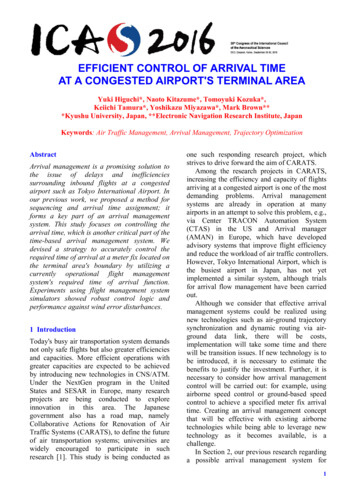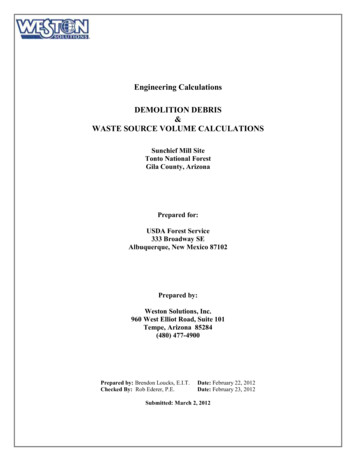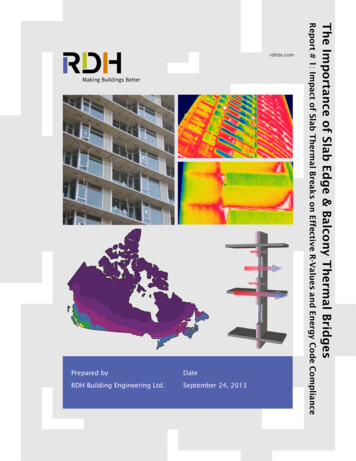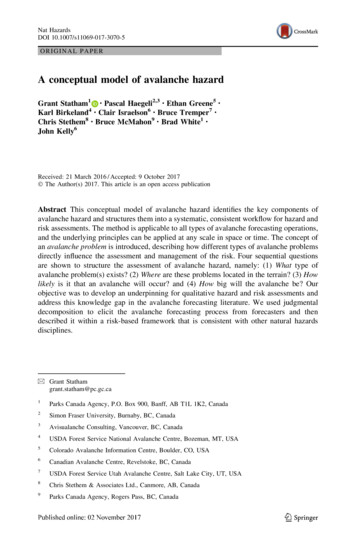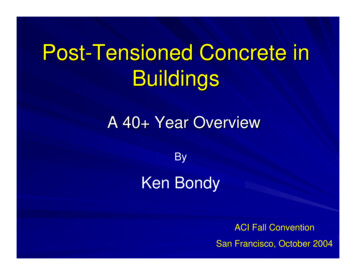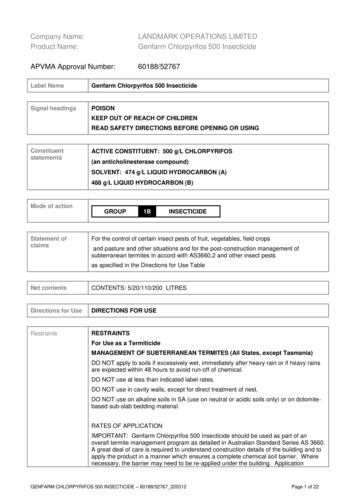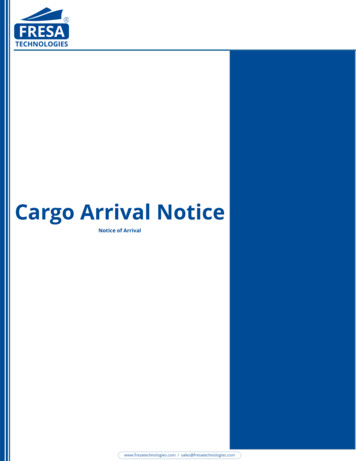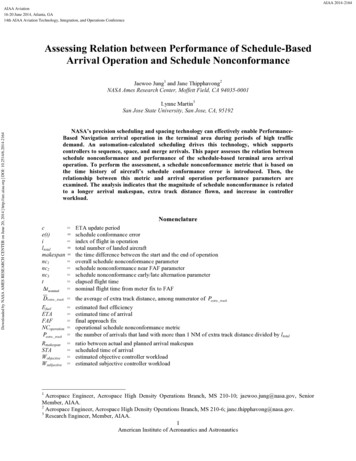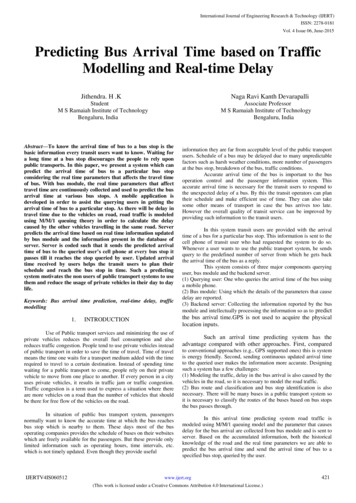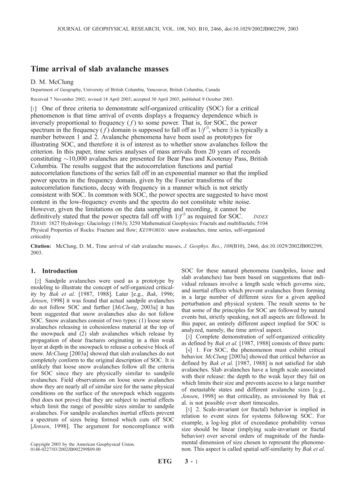
Transcription
JOURNAL OF GEOPHYSICAL RESEARCH, VOL. 108, NO. B10, 2466, doi:10.1029/2002JB002299, 2003Time arrival of slab avalanche massesD. M. McClungDepartment of Geography, University of British Columbia, Vancouver, British Columbia, CanadaReceived 7 November 2002; revised 18 April 2003; accepted 30 April 2003; published 9 October 2003.[1] One of three criteria to demonstrate self-organized criticality (SOC) for a criticalphenomenon is that time arrival of events displays a frequency dependence which isinversely proportional to frequency ( f ) to some power. That is, for SOC, the powerspectrum in the frequency ( f ) domain is supposed to fall off as 1/f b, where b is typically anumber between 1 and 2. Avalanche phenomena have been used as prototypes forillustrating SOC, and therefore it is of interest as to whether snow avalanches follow thecriterion. In this paper, time series analyses of mass arrivals from 20 years of recordsconstituting 10,000 avalanches are presented for Bear Pass and Kootenay Pass, BritishColumbia. The results suggest that the autocorrelation functions and partialautocorrelation functions of the series fall off in an exponential manner so that the impliedpower spectra in the frequency domain, given by the Fourier transforms of theautocorrelation functions, decay with frequency in a manner which is not strictlyconsistent with SOC. In common with SOC, the power spectra are suggested to have mostcontent in the low-frequency events and the spectra do not constitute white noise.However, given the limitations on the data sampling and recording, it cannot beINDEXdefinitively stated that the power spectra fall off with 1/f b as required for SOC.TERMS: 1827 Hydrology: Glaciology (1863); 3250 Mathematical Geophysics: Fractals and multifractals; 5104Physical Properties of Rocks: Fracture and flow; KEYWORDS: snow avalanches, time series, self-organizedcriticalityCitation: McClung, D. M., Time arrival of slab avalanche masses, J. Geophys. Res., 108(B10), 2466, doi:10.1029/2002JB002299,2003.1. Introduction[2] Sandpile avalanches were used as a prototype bymodeling to illustrate the concept of self-organized criticality by Bak et al. [1987, 1988]. Later [e.g., Bak, 1996;Jensen, 1998] it was found that actual sandpile avalanchesdo not follow SOC and further [McClung, 2003a] it hasbeen suggested that snow avalanches also do not followSOC. Snow avalanches consist of two types: (1) loose snowavalanches releasing in cohesionless material at the top ofthe snowpack and (2) slab avalanches which release bypropagation of shear fractures originating in a thin weaklayer at depth in the snowpack to release a cohesive block ofsnow. McClung [2003a] showed that slab avalanches do notcompletely conform to the original description of SOC. It isunlikely that loose snow avalanches follow all the criteriafor SOC since they are physically similar to sandpileavalanches. Field observations on loose snow avalanchesshow they are nearly all of similar size for the same physicalconditions on the surface of the snowpack which suggests(but does not prove) that they are subject to inertial effectswhich limit the range of possible sizes similar to sandpileavalanches. For sandpile avalanches inertial effects preventa spectrum of sizes being formed which cuts off SOC[Jensen, 1998]. The argument for noncompliance withCopyright 2003 by the American Geophysical Union.0148-0227/03/2002JB002299 09.00ETGSOC for these natural phenomena (sandpiles, loose andslab avalanches) has been based on suggestions that individual releases involve a length scale which governs size,and inertial effects which prevent avalanches from formingin a large number of different sizes for a given appliedperturbation and physical system. The result seems to bethat some of the principles for SOC are followed by naturalevents but, strictly speaking, not all aspects are followed. Inthis paper, an entirely different aspect implied for SOC isanalyzed, namely, the time arrival aspect.[3] Complete demonstration of self-organized criticalityas defined by Bak et al. [1987, 1988] consists of three parts:[4] 1. For SOC, the phenomenon must exhibit criticalbehavior. McClung [2003a] showed that critical behavior asdefined by Bak et al. [1987, 1988] is not satisfied for slabavalanches. Slab avalanches have a length scale associatedwith their release: the depth to the weak layer they fail onwhich limits their size and prevents access to a large numberof metastable states and different avalanche sizes [e.g.,Jensen, 1998] so that criticality, as envisioned by Bak etal. is not possible over short timescales.[5] 2. Scale-invariant (or fractal) behavior is implied inrelation to event sizes for systems following SOC. Forexample, a log-log plot of exceedance probability versussize should be linear (implying scale-invariant or fractalbehavior) over several orders of magnitude of the fundamental dimension of size chosen to represent the phenomenon. This aspect is called spatial self-similarity by Bak et al.3-1
ETG3-2MCCLUNG: TIME ARRIVAL OF AVALANCHES[1988]. McClung [2003a] considered spatial self-similarityfor slab avalanches with linkage to the fundamental releasemechanism of shear fracture propagation in the weak layerfound beneath slabs which release. Bažant et al. [2003] andMcClung [2003a] showed that there is a fundamental lengthscale associated with dry slab initiation: the slab thickness,D. McClung [2003a] showed that slab avalanches sizes arenot scale-invariant with D over any significant range ofsizes.[6] 3. For SOC, arrival of events, when looked at in thefrequency domain, have a power spectrum which falls offwith a negative power of frequency called 1/f noise or‘‘flicker noise.’’ Mathematically, it is implied that the powerspectrum of arrivals in the frequency domain falls off withan algebraic power law as 1/f b where b is typically fractalbetween 1 and 2 [Bak, 1996; Jensen, 1998].[7] Conclusions, thus far for snow and sandpile avalanches are that they do not strictly obey all the criteriafor SOC but some of the characteristics of SOC arefollowed. These conclusions are based mainly on analysisfor the first two criteria for SOC listed above. This papercontains analysis relevant to the third part of SOC: the timearrival of avalanche masses. The conclusions are drawnfrom slab avalanches recorded over twenty consecutivewinters (1981 –2001) for two avalanche areas for aboutten thousand avalanches. The records provide time serieswith lengths of more than 8,000 time intervals which can beused to study the time-frequency signature aspect suggestedfor SOC. The results, together with those of McClung[2003a], again show that some characteristics of SOCoriginally defined by Bak et al. [1987] are satisfied but ifthe criteria outlined by Bak et al. [1987] are strictly appliedthen SOC is not satisfied for slab avalanches. The combinedresults are demonstrated for a physical phenomenon (slabavalanches) from field measurements, estimates, and observations without resorting to computer modeling so that theymay contribute to the physical constraints needed to refine thedefinition of SOC to make it applicable to natural phenomenain a meaningful way.[8] If SOC does not apply to natural avalanche events(snow and sandpile avalanches) then there is need forinformation to illustrate the characteristics of these natural,unstable systems. The analysis in this paper is intended tocontribute to the information base. Slab avalanches, similarto earthquakes, are destructive, catastrophic events whichinitiate by fracture propagation. The information in this papermay help to link natural events within a system definition.2. Character of Time Series Data[9] The data consist of avalanche events recorded byprofessional avalanche forecasters for two avalanche areasin British Columbia. Kootenay Pass is located in southeastern British Columbia along a stretch of highway withapproximately 50 large avalanche paths affecting the highway and Bear Pass is a stretch of highway in northwesternBritish Columbia with also about 50 large avalanche pathsaffecting the highway. Typically approximately 200 days,1 November through May, constitute the avalanche seasoneach year during which avalanche events are recorded eachday by the forecasters. The data included were collecteddaily for 20 winters from 1980 – 1981 through 2000 – 2001.[10] The snow climates and terrain features may differ forBear Pass and Kootenay Pass and geographically they areseparated from each other by a distance of 1000 km in anorthwest southeast line. Bear Pass has numerous very largeavalanche paths with start zones in high alpine terrain withfew influences of vegetation or forest cover. Kootenay Passhas much smaller start zones and avalanche paths onaverage than Bear Pass. McClung and Tweedy [1994] foundthe variables which are significant predictors of avalancheactivity at Kootenay Pass and Floyer and McClung [2003]did the same for Bear Pass. In spite of the geographicalseparation, the predictor variables are very similar. Meanannual snowfall is about 12 m for Kootenay Pass and it isabout 15 m for Bear Pass but the avalanche season typicallylasts longer at Bear Pass. These data suggest that sinceavalanche frequency is related to snow supply, a comparablefrequency of avalanching is expected for both areas. However, terrain features suggest larger accumulated massesfrom storms at Bear Pass due to larger avalanche pathsthere.[11] The avalanche occurrence data were recorded on thefive-part Canadian size classification scale [e.g., McClungand Schaerer, 1993, p. 253]. The classification scale isbased on destructive potential and it includes an importantorder of magnitude estimate of the avalanche mass withmass increasing by about an order of magnitude for eachstep in size: size 1 is about 10 t, size 2 is about 100 t, size 5is about 100,000 t. There are other attributes to the sizesystem such as path length scale. However, the mostimportant variable is the avalanche mass. Accordingly, itis assumed for this study that sizes recorded are convertedinto mass according to: mass 10size with the massexpressed in metric tons. The data were often recordedusing half sizes and the same conversion formula was used.For example, size 2.5 was assigned a mass of 316 t. Thismethod of mass conversion is an approximation but fororder-of-magnitude estimates required here it should havesufficient accuracy.3. Time Series[12] Avalanche events and snow and weather data arecollected for avalanche forecasting purposes at Kootenayand Bear Passes. For numerical avalanche forecasting,avalanche events must be roughly correlated with the snowand weather observations. McClung and Tweedy [1994]successfully developed a computer assisted avalanche forecasting model for Kootenay Pass. For the model, recordedavalanche events were placed in two daily time periods ofroughly 12 hours. This same time frame for data recordswas used to construct the time series in this study. Thusavalanche occurrence events were lumped into two timeperiods per day: those recorded before 1200 LT, and thoserecorded after 1200 LT until approximately 0000 LT.[13] The time series were constructed by adding all themasses of avalanches recorded during each of two timeperiods per day by the mass conversion formula givenabove to give order-of-magnitude estimates of mass forapproximately 50 avalanche paths for each time period. Ofcourse, there are many time periods with no avalanchesrecorded and these records were given mass zero andln(mass) 0. The time series were constructed by placing
MCCLUNG: TIME ARRIVAL OF AVALANCHESthe data records for each winter sequentially with summerperiods excluded. Therefore the constructions do not represent true time series since summer and fall periods wereexcluded. Had summer and fall periods been included, noadditional useful information about time arrival of avalanche events would result. Further, had summer and falltime periods been included, the generating perturbation forproducing avalanches (snow storms) would have beenswitched off over half the year and the stationary assumption (discussed below) would not be viable. However, thedata include all periods when avalanches are possible byapplication of perturbations from weather conditions and byhuman influences e.g., avalanche control. Since the focus ofthis paper is on an examination of time arrival of avalancheevents it seems reasonable to exclude the time periods insummer and fall when avalanches are not possible. Takentogether, the time series consist of more than 8000 sequential total avalanche mass arrival records for each of BearPass and Kootenay Pass. The series contain avalanche massarrival records consisting of more than 5000 of avalanchesfor each avalanche area.[14] Size one avalanches are mainly loose snow avalanches (sluffs) in the Canadian size system. Some size 1avalanches are present in the databases but only to a limitedextent. For the mass sums represented by the databases, theeffects of loose snow avalanches will be small or negligible.Thus it can be taken that the time series used in this paperlargely represent the mass arrival signature of slab avalanches. Size 1 avalanches are often not recorded byavalanche forecasters since they often stop high above thehighways with no effect on operations. Also, observationsof them are often obscured by poor visibility associated withstorms and mountain weather.[15] The study of McClung [2003a] was targeted towardsize scaling as related to spatial self-similarity for snow slabavalanches and the time series for mass arrival in the presentstudy also apply to slab avalanches. McClung [2003a] andBažant et al. [2003] showed that for individual slab avalanches there is an important length scale which governs thesize: the slab depth D to the weak layer. Since the depth tothe weak layer can only vary considerably if studied oversignificantly large areas over a long time, SOC for the snowslab is only possible if the ‘‘system’’ studied applies to largespatial areas over long times. Therefore, if SOC is to beapplied, it must be studied in the context of an ensemble‘‘time and spatial average’’ over a significant area withthousands of events allowing variations in D over severalorders of magnitude. Thus the present study is orientedtoward that concept with avalanche events summed twicedaily for each of the two avalanche areas to study the timearrival aspect of SOC.3.1. Avalanche Triggers[16] The time series used in this study consist mostly ofslab avalanches which occurred either naturally (withouthuman intervention) and by application of explosive control.In the analysis below, the time series were analyzed according to natural and human triggered events. For Bear Pass, theanalysis below includes just the natural events but analysis ofall the events together showed that the conclusions are notaltered. For Kootenay Pass, similar conclusions followexcept that at Kootenay Pass recent years have been char-ETG3-3Figure 1. Mass arrival versus time at Bear Pass: 1980–1981 through 2000 – 2001. The mass is calculated as thesum of masses during two 12 hour periods per day for allthe avalanche paths at Bear Pass. Only natural events areincluded.acterized by more extensive application of explosives suchthat the ‘‘time flow of events’’ may have been altered to affectthe stationary assumption for the series.3.2. Stationary Assumption[17] Physically, a stationary process implies that therandom mechanism which generates the process does notchange as time progresses. In this paper, the generatingprocess consists of snow storms and weather conditionswhich produce snow instability in the regions. Climatechange could alter this generating process but there are nodata to suggest that such is the case for the data analyzed inthis paper. Individual avalanche events clearly do notqualify as a stationary process because they involve a singleevent over a short time interval. In order to qualify as astationary process, a shift in the time axis describing theflow of events should not alter the conclusions. The remarkabove about more vigorous application of avalanche controlto release avalanches at Kootenay Pass in the past 10 yearsmakes the stationary assumption more questionable than forBear Pass for which the data consist only of natural events.This problem could be dealt with for Kootenay Pass bysplitting the series into two 10 year time series but this is notnecessary for the arguments in this paper and it is beyondthe scope here.3.3. Presentation of Time Series and Assumptions[18] Figure 1 shows the time series of natural avalancheevents for Bear Pass. The data from the years 1980 – 1981through 2000– 2001 are represented. In Figure 1, the avalanche events are ‘‘naturals’’ without application of explosives so the assumption of stationarity should be fulfilled:the same process controls the flow of events throughout theduration of the series.[19] Figures 2 and 3 show similar time records forKootenay Pass. Figure 2 shows all avalanches (natural andexplosive controlled), and Figure 3 shows just the naturalevents at Kootenay Pass. Comparison of these figuressuggests that for Kootenay Pass the assumption of stationarity is not as good as expected for Bear Pass.[20] For the analysis in this paper, the data from Figure 1(Bear Pass naturals) has been used for most of the analysissince it is expected that the stationary assumption will be a
ETG3-4MCCLUNG: TIME ARRIVAL OF AVALANCHESFigure 2. Mass arrival versus time at Kootenay Pass:1980 – 1981 through 2000 – 2001. The mass is calculated asthe sum of masses during two 12 hour periods per day forall the avalanche paths at Kootenay Pass. All events, naturaland explosive controlled, are included.good one. Conclusions will also be drawn from KootenayPass (Figure 2, all avalanches) but the stationary assumptionis probably not as good for the entire series.[21] From inspection of Figures 1 – 3, it is suggested thatthe time series may display some of the aspects of timearrival signature for 1/f b noise: the time series do notrepresent white noise. In the time series (e.g., Figures 1and 2) there is correlation between from one value to thenext and but there are large peaks and fluctuations in theseries. Nor are the series periodic with a single fixedfrequency or even a few fixed embedded frequencies. Thiswas proven by calculating periodograms for Bear Pass andKootenay Pass which showed many frequencies contributeto the spectrum. Autocorrelation functions were used tomake inferences about the power spectra in this paper asshown below. Since the power spectrum is the Fouriertransform of the autocorrelation function, knowledge ofthe autocorrelation function is mathematically equivalentto knowledge of the power spectrum [Box and Jenkins,1976].[22] Inspection of the time series in Figures 1 and 2reveals that they are strong candidates for at least somecharacteristics of what Bak et al. [1987, 1988] describe as1/f b noise. However, it is not obvious, meaning that whentransformed into the frequency domain, the power spectrumfalls off with a negative power of the frequency and most ofthe power is in the low-frequency (high-magnitude) events.Further analysis is given below.Figure 3. Similar to Figure 2 but including only naturalevents.(mean 5.95, SD 1.69, N 1133 cases) and I suggest thatthis is due to the higher number of very large avalanche pathsat Bear Pass compared to Kootenay Pass. McClung [2003b]presented a study of magnitude and frequency of avalanchesfrom Bear Pass and Kootenay Pass which illustrates thedifferences in terrain and avalanche magnitude for the twoareas.[24] Notice that for small mass sums at both Bear Passand Kootenay Pass, there is a lack of fit on the probabilityplots. This is due to single small avalanches which aremostly loose snow avalanches of size 1 (the lower limit ofthe size system). Also, for Kootenay Pass there is a lack offit at the highest masses for Figure 5. Figure 6 includes justthe natural avalanches and the lack of fit at high mass sumdoes not occur. Therefore it is suggested that for naturalavalanches the lognormal pdf is followed for both areas and4. Probability Density Function for MassMagnitudes[23] Figures 4, 5, and 6 are probability plots for summedmass magnitudes corresponding to Figures 1 (naturals, BearPass), 2 (all avalanches, Kootenay Pass), and 3 (naturals,Kootenay Pass). Figures 4, 5, and 6 imply that the pdfs ofmass (t) summed in time intervals obey a lognormal distribution or equivalently, ln(mass) obeys a Gaussian distribution. In spite of a comparable time length for both series(20 winters) and comparable number of avalanche paths, themean of ln(mass) is larger for Bear Pass (mean 6.67, SD 1.76, N 1940 cases) than for Kootenay Pass, all avalanchesFigure 4. Probability plot for summed arrival masses forthe data in Figure 1 from Bear Pass. It is suggested that ln(mass summed) follows a Gaussian distribution which isrepresented by the least squares line.
MCCLUNG: TIME ARRIVAL OF AVALANCHESFigure 5. Probability plot for summed arrival masses forthe data in Figure 2 from Kootenay Pass (all avalanches).Similar to Figure 4 suggesting that ln(mass summed)follows a Gaussian distribution.the lack of fit at high mass for Kootenay Pass is due toapplication of avalanche control: the actual masses appear tobe less than if they had come naturally. The primary goal ofapplication of avalanche control is to reduce the expectedavalanche sizes so this effect is not surprising.5. Autocorrelation Plots for Bear Pass andKootenay Pass[25] In order to assess the characteristics of the time seriesin the frequency domain, it is useful to construct autocorrelation plots. Given an autocorrelation function then thepower spectrum in the frequency domain is obtained by itsFourier transform. For 1/f b noise as described by Bak et al.[1987, 1988] and Jensen [1998] it is required that points inthe time series are correlated to previous times and that thepower spectrum is not constant. The power spectrum shouldfall off as frequency increases with most power contained inthe low-frequency portion of the spectrum.[26] Figures 7 and 8 show the first-order autocorrelationfunctions (ln(mass) with means removed) for Bear Pass(naturals) and Kootenay Pass (all avalanches). Before calculating the autocorrelation functions, smoothing wasapplied to the series by a moving average over 2 lags. Thiswas done to smooth the data to allow for the possibility ofuneven recording between the two 12 hour periods for eachday which the data were stratified into. A moving averagefilter with weights: 1:2:1, respectively, was also applied andthe results were not significantly altered. Such 1:2:1smoothing is known to have little effect on the frequencyimplied by the spectrum. Figures 7 and 8 show that theautocorrelation functions (ACF) fall with an exponentiallike dependence in a rapid manner. According to Box andJenkins [1976] such rapid decline suggests the series may beETG3-5Figure 6. Probability plot for summed arrival masses forthe data in Figure 3 (natural avalanches) from KootenayPass. It is suggested that ln(mass summed) follows aGaussian distribution. In comparison to Figure 5, the lack offit at high masses is less evident which suggests that theeffects of avalanche control may be present in Figure 5.stationary. Further, Box and Jenkins [1976] show that timeseries associated with such behavior do not represent whitenoise. Instead, it is implied that the power spectra (theFourier transform of the autocorrelation functions) fall offrapidly with frequency with most ‘‘power’’ in the lowfrequency portion. Figures 7 and 8, then, suggest that thetime series satisfy some of the basic the conditions for 1/f bnoise. Figures 7 and 8 include significance testing. If theautocorrelation function falls within the solid lines includedFigure 7. First-order autocorrelation function for the timeseries in Figure 1 from Bear Pass. The autocorrelationfunction is calculated for ln(mass) with the mean removedfrom the series. The horizontal lines represent the limits oftwo standard errors (or 95% confidence limits): correlationsinside these lines are not significant. The data were smoothedusing a moving average of two lags.
ETG3-6MCCLUNG: TIME ARRIVAL OF AVALANCHESFigure 8. Similar to Figure 6 for the time series in Figure 2from Kootenay Pass. The horizontal lines represent thelimits of two standard errors (or 95% confidence limits):correlations inside these lines are not significant. The datawere smoothed using a moving average of two lags.on the plots, correlations are not significant. The solid linesrepresent 95% confidence limits for the significance of thecorrelations.[27] Figures 7 and 8 are represent autocorrelations of theseries ln(mass) with only the mean removed and minimalsmoothing (2 lag moving average). The calculations suggesta rapid decline indicating autocorrelations drop rapidly in afew lags. It is implied that the series from Bear Pass andKootenay Pass have correlations which drop to about 1/e oftheir initial values of one in a few lags. This suggests thepower spectrum declines rapidly, as expected for the 1/f bnoise [e.g., Bak, 1996]. The autocorrelation functions alsoshow that the values in the series are correlated with previousvalues which Bak [1996] explains is a necessary feature ofSOC. The timescale for dropping to 1/e for both seriescorresponds approximately to one standard deviation ofavalanche arrival time of about 1 day during and afterstorms. This is shown below with simple modeling concepts.[28] The autocorrelation functions in Figures 7 and 8 arevery nearly identical and they fall off with an exponentialdependence. Empirically, both ACFs decline exponentiallyto a value of about 0.1 at lag 20 with very slow decline afterlag 20. I fitted the ACFs over the first 20 lags with a nonlinearnumerical model of the form: 0.1 C1 exp( u/C2), where uis lag, C1 and C2 are constants. For Kootenay Pass, Iobtained: C1 0.91, C2 2.3 with 95% confidence limitson C2 between 2.1 and 2.6 (R2 0.99, where R is thePearson correlation coefficient). For Bear Pass, the resultswere: C1 0.88, C2 2.4 with 95% confidence limitsbetween 2.1 and 2.6 (R2 0.97). These results suggest thatempirically the ACF has an initial exponential decline withan e-folding time of about 2 lags (or 1 day). I also fitted theACFs over the first 20 lags with a similar function containing exp u2 but the fit was not nearly as good as withthe function exp u.6. Partial Autocorrelation Functions[29] Theoretically [Box and Jenkins, 1976], the autocorrelation function extends to infinity. Partial autocorrelationfunction (PACF) plots show the relationships of the valuesin the series after partialing out the influence of theintervening points. The PACF plots reveal effects whichdo not depend linearly on the previous autocorrelations.Figures 9 and 10 show the PACF plots for Bear Pass(naturals) and Kootenay Pass (all avalanches) calculatedafter removing the mean and smoothed with moving averages of two lags as for the ACF plots. The correlations aresignificant to about 20 lags. Box and Jenkins [1976] presenttechniques to classify time series on the basis of ACF andPACF plots. According to Box and Jenkins [1976] whenboth the ACF and PACF decline rapidly in an exponentialmanner, such as the examples here, it suggests that theseries are mixed processes combining autoregressive andmoving average components. It is beyond the scope of thepresent paper to develop forecasting models from the serieshere. In a later section, I develop a model for estimating thereturn period for summed avalanche masses which may beused in planning. For SOC, the most important results arethat the ACF and PACF plots fall off exponentially and theform of the power spectrum is suggested by the Fouriertransform of the ACF plot.7. Power Spectrum for Poisson Process asShot Noise[30] The previous results show that the autocorrelationfunctions for the series display exponential decay. Autocorrelation functions of time series are rather analogous tohistograms for analyzing the statistical frequency of occurrence of a variable [Box and Jenkins, 1976]. Since theautocorrelation functions are calculated directly from thetime series, inferences made from them are probably the bestinformation available for making conclusions. However,they do not provide direct information about the powerspectrum. In this section, information derived from theautocorrelation functions is combined with a simple physicalmodel in an attempt to illustrate some possible features of theFigure 9. Partial autocorrelation function for the timeseries in Figure 1 from Bear Pass. The partial autocorrelations are calculated for ln(mass) with the mean removedfrom the series. The horizontal lines represent the limits oftwo standard errors (or 95% confidence limits): correlationsinside these lines are not significant. The data weresmoothed using a moving average of two lags.
ETGMCCLUNG: TIME ARRIVAL OF AVALANCHESFigure 10. Similar to Figure 8 for the time series inFigure 2 from Kootenay Pass. The horizontal lines representthe limits of two standard errors (or 95% confidence limits):correlations inside these lines are not significant. The datawere smoothed using a moving average of two lags.implied power spectra. However, the conclusions drawndepend on model assumptions so that there is more uncertainty about conclusions which arise from the analysis thanfrom the autocorrelation functions. Given this limitation, Inow employ a simple model which is consistent with theautocorrelations and some of the known facts about avalanche events.[31] Avalanches events are rare, discrete independentevents for which arrival may be characterized approximatelyby a Poisson process under an applied loading perturbation[McClung, 1999]. This approximation holds providedenough time is considered between events to
phenomenon is that time arrival of events displays a frequency dependence which is inversely proportional to frequency ( f ) to some power. That is, for SOC, the power spectrum in the frequency ( f) domain is supposed to fall off as 1/f b, where b is typically a number between 1 and 2. Avalanche phenomena have been used as prototypes for
